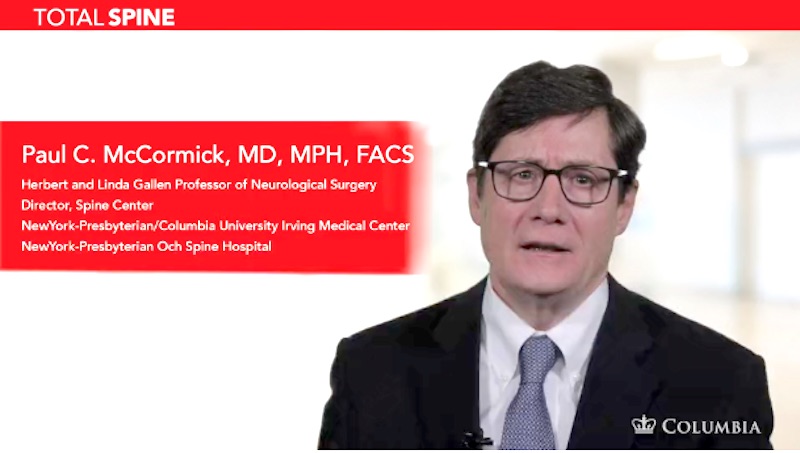Advanced Techniques Benefit Patients With Spinal Conditions From Back Pain and Stenosis to Spinal Deformity and Spinal Cancer NEW YORK (Nov, 2009)
Minimally invasive techniques have become standard for many procedures, from the removal of the gallbladder to angioplasty, but the approach is now only beginning to be available to patients with spinal conditions. The surgical team at NewYork-Presbyterian Hospital/Columbia University Medical Center’s Spine Center aims to bring the benefits of minimally invasive surgery for patients with intractable back pain, stenosis, spinal deformity, even spinal cancer. “Despite the availability of minimally invasive alternatives, as many as 90 percent of common procedures like discectomy and lumbar fusion are still performed using traditional open surgery,” says Dr. Alfred Ogden, director of the minimally invasive spine surgery program at NewYork-Presbyterian Hospital/Columbia University Medical Center and Assistant Professor of Neurological Surgery at Columbia University College of Physicians and Surgeons. “With specialized training and technologies available at spine centers such as our own, we can now offer patients these procedures and others, with all the advantages of less-invasive surgery.”
According to the American Association of Neurological Surgeons, a shift to the minimally invasive surgery would translate into tangible benefits to patients, including dramatically smaller incisions, less pain, reduced blood loss, shorter hospital stays and faster recovery.
Dr. Ogden agrees, citing additional advantages: Less pain means less demand for narcotics, and reduced blood loss means fewer transfusions. And, unlike traditional open surgery, rehab is rarely needed after a minimally invasive procedure. All of these, in turn, reduce the cost of care for patients and the health care system as a whole, says Dr. Ogden.
Tubular Retractors
The biggest technological advance, in the estimation of Dr. Ogden, has been the invention of tubular retractors, which allow the spine surgeon to insert a tube through a small incision close to the problem area, gently spread the muscles apart rather than cut through them, and perform delicate procedures such as: *
- Discectomy, in which part or all of a disc is removed — typically, to relieve back and leg pain caused by a herniated lumbar disc.
- Laminectomy, involving the removal of the rear part of a vertebra to relieve pressure on a pinched nerve.
- Spinal fusion, in which the surgeon connects two or more vertebrae using bone grafts — the surgical treatment of choice for the excruciating pain seen in some cases of degenerative disc disease.
- Spinal tumors in which tumors arising from inside or near the spinal canal are removed
The Next Frontier
The field of minimally invasive spine surgery is poised for rapid growth, Dr. Ogden predicts. Some patients with spinal metastases are now candidates for minimally invasive procedures with bolder objectives such as corpectomy, in which the surgeon removes the entire vertebral body in front of the spinal canal to allow for removal of a cancerous tumor. Deformity surgery to correct severe scoliosis or kyphosis, or humpback, is also on the horizon.
“Going forward, we’ll need larger studies comparing minimally invasive procedures with open versions for specific diseases and conditions of the spine,” says Dr. Ogden. Early data show that minimally invasive surgical outcomes are at least as good as those associated with open procedures.
“In the meantime,” he continues, “we will refine the techniques bring their benefits to more and more patients.”
For more information, patients may call (866) NYP-NEWS.
NewYork-Presbyterian Hospital/Columbia University Medical Center
NewYork-Presbyterian Hospital/Columbia University Medical Center, located in New York City, is one of the leading academic medical centers in the world, comprising the teaching hospital NewYork-Presbyterian and its academic partner, Columbia University College of Physicians and Surgeons. NewYork-Presbyterian/Columbia provides state-of-the-art inpatient, ambulatory and preventive care in all areas of medicine, and is committed to excellence in patient care, research, education and community service. NewYork-Presbyterian Hospital also comprises NewYork-Presbyterian Hospital/Weill Cornell Medical Center, NewYork-Presbyterian Morgan Stanley Children’s Hospital, NewYork-Presbyterian Hospital/Westchester Division and NewYork-Presbyterian Hospital/The Allen Hospital. NewYork-Presbyterian is the #1 hospital in the New York metropolitan area and is consistently ranked among the best academic medical institutions in the nation, according to U.S.News & World Report. For more information, visit www.nyp.org.
Contact: Gloria Chin [email protected] (212) 305-5587


